---------------------------------------------------------
It is undeniable that rabbits are adorable and have lots of personality. Rabbits are not right for every family, however. Following are the questions you should ask yourself before adding rabbits to your farm or family.
Why are you looking to get rabbits?
Rabbits are multipurpose animals. Deciding ahead of time what purpose your rabbits will serve will help you narrow down the breed and setup you will need. All rabbit breeds can make wonderful pets and many people keep them strictly as pets, both indoors and outdoors.
Angora rabbits can provide fiber for those that enjoy spinning, knitting, and other fiber crafts. Collecting the fiber does not harm the animal and is a necessary part of caring for these fluffy rabbits. click here to read more about the different angora breeds. Many larger breed rabbits can be raised to provide sustainable meat for your farm. The most popular breeds of meat rabbits are New Zealand, Flemish Giant, Californian, and Rex. Breeding and showing rabbits is another popular use of rabbits. Rabbits of all kinds will provide you with plenty of manure for those that enjoy gardening. click here to read more about using rabbit manure in the garden
Do you have the space to keep rabbits?
Gone are the days of keeping rabbits in small wire cages in the far corner of the yard. Healthy rabbits need room to roam, hop, and explore, as well as social interaction. No matter what reason you are raising rabbits for, you want them to be healthy & happy.
Colony Raised vs Separate Cages
For many, many years rabbits were only raised in separate cages, one rabbit per cage. This keeps the rabbits from fighting and injuring each other & controls breeding. It also allows the caregiver to closely monitor how much each rabbit is eating, drinking, and pooping. Many people still raise their rabbits in this manner. When done properly it is a safe & easy way to house rabbits. As long as each rabbit’s area is large enough and the rabbits are given social interaction time this traditional method works fine. Social time for the rabbits can either be with their human caretaker or with other rabbits while supervised.
Isolated enclosures are easy for caretakers, but this is not how rabbits live in the wild. Wild rabbits live in colonies of 2 to over 2 dozen. Your domesticated rabbits have these same instincts for living in social settings. Many rabbit keepers are transitioning to a more natural colony setting for their rabbits. Colony-raised rabbits are kept in a big communal area and allowed to freely interact. This area could be a bedroom, barn, shed, or large enclosure. While some rabbits do not have the personality to handle colony life, most rabbits thrive in this setting. To avoid unwanted litters you will need to either separate males & females or get your animals fixed. click here to read more about colony raising your rabbits
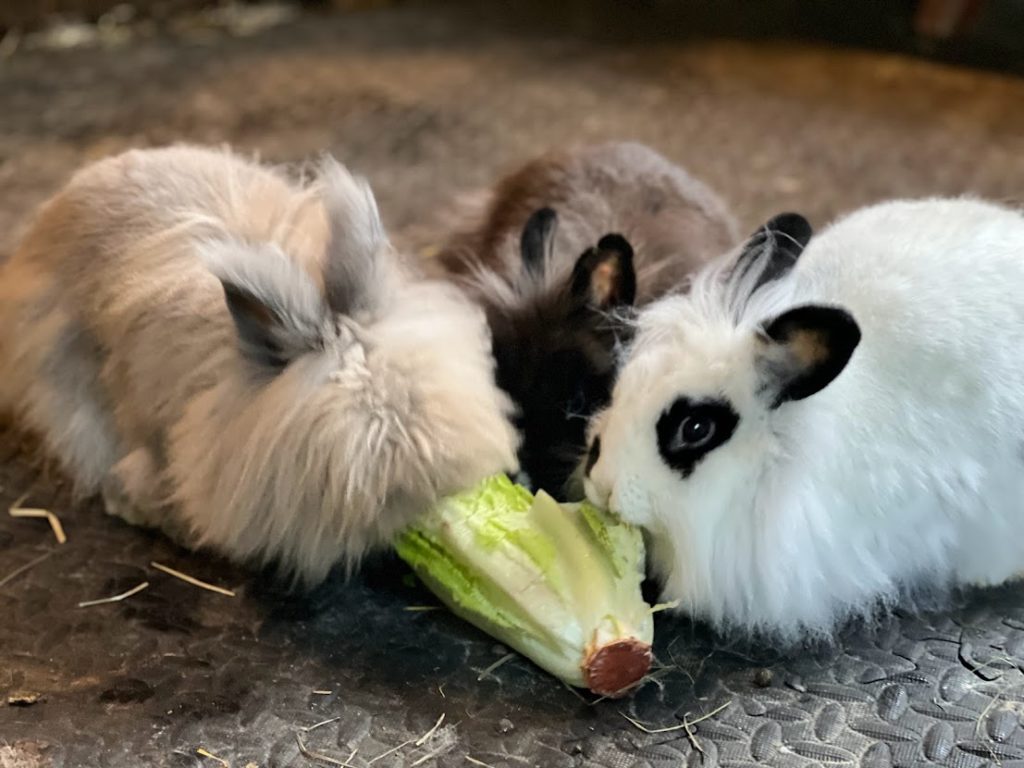
Rabbit Space Requirements
The first thing you need to decide when setting up a rabbit space is will your rabbit live indoors or outdoors. Rabbits can successfully be raised both inside or outside, both have their own set of advantages and disadvantages. click here to read more about deciding between indoor & outdoor rabbits.
If raising rabbits inside you will need a roomy cage. Aim for at least 10 square feet per rabbit PLUS an exercise pen (at least 25 square feet per rabbit). If you are raising large breeds, you should make the space even bigger. They should have access to their excise pen every day. The best situation is to make the exercise pen secure (the rabbit can’t escape & the space is rabbit safe). The rabbit can then have access 24/7 to their exercise pen and never have to be locked in the cage. Rabbits can be litter box trained. Many indoor rabbit owners will keep their rabbit in the cage/exercise pen at night and when they aren’t home, but allow their rabbit to free roam the house when supervised. click here to read about litter training rabbits
Outdoor rabbits will need the same amount of space as indoor rabbits (about 35 square feet per rabbit combined enclosed & exercise space). If your rabbit will be living outside you should not keep just one rabbit. You should have at least one other rabbit friend either in the same pen or a neighboring pen. Outdoor rabbit enclosures need to be rabbit safe & ensure they can’t escape. Outside you have the added requirement of keeping your rabbits safe from predators & the elements. You could convert a shed, barn, or garage, or use a traditional rabbit hutch and build an exercise pen around it. click here to read about setting up an outdoor enclosure
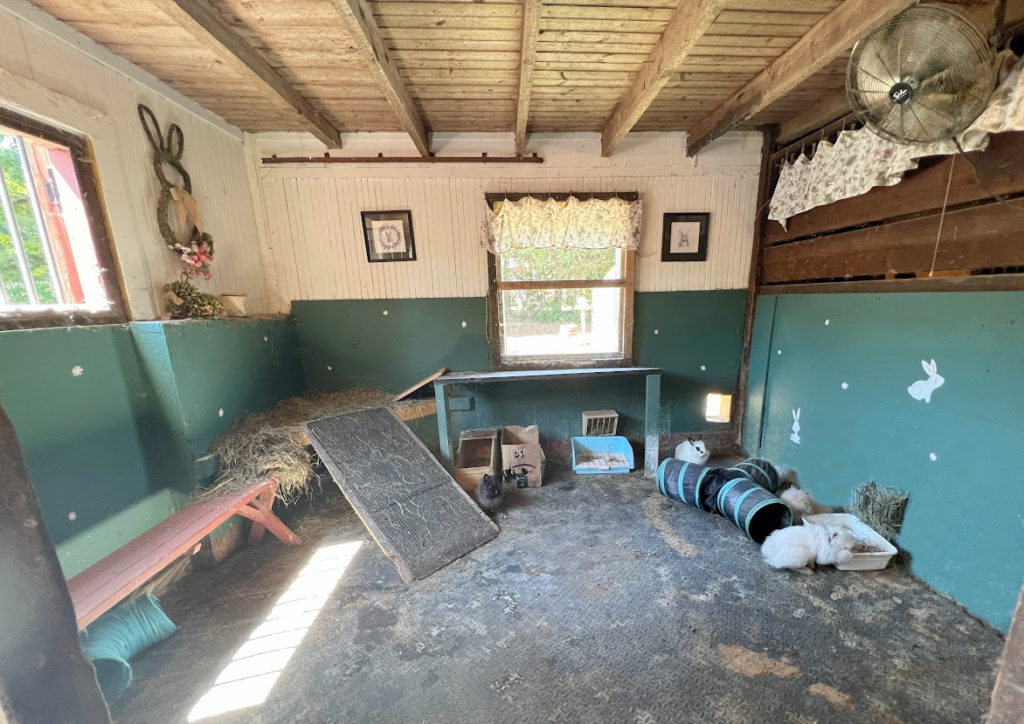
Meat or breeding rabbits
When keeping rabbits that will be bred, the space requirements per rabbit are the same. You will need to make additional accommodations for keeping both unaltered males & females, and possibly another space for grow outs (kits that have been weaned but haven’t been processed or sold yet). Be aware that it is not unheard of for males to successfully breed through wire cage walls!
It is best if the males & females are kept in areas where they can not see each other. If they can see each other in pens, the males will spend much of their day pacing the enclosure line. In a colony setting unaltered males will fight other males to show off for the females. If you colony raise & have a high need for rabbit meat, males can be kept with the females full time. To limit fighting you should have at least 6-7 females for each male. Also, provide plenty of space for females to escape unwanted breeding & males to escape bullies.
Do you have time to keep rabbits?
Rabbits do not take as much time as traditional pets like dogs. Anytime you take responsibility for an animal you need to be realistic about how much time you’ll need to spend on care. Every day you will need to spend at least 15 minutes cleaning the enclosure & litter box, and filling their feed & water. If your rabbits are outdoors you need to be committed to doing this in all kinds of weather.
Additionally, you should plan to spend at least 15-30 minutes daily hanging out in your rabbit’s space socially. The more time you spend with your rabbits, the friendlier they will be and the more you will enjoy them! When keeping meat rabbits, you might not want to spend time bonding with them. Bu you will still need to spend some time in the rabbit area observing their behavior. As prey animals, rabbits are excellent at hiding illness & injury. The more time you spend learning “normal” behavior the easier it will be to spot a problem early.
Grooming
If you keep fiber or long-haired rabbits you need to plan for a good amount of time grooming. If they are not groomed regularly, their fur will mat making it unusable for spinning. It can even endanger their lives. Ungroomed rabbits will groom themselves, ingesting the loose fur. This can clog their digestive system which can be deadly for rabbits (click here to read more about GI Stasis).
When I first started keeping rabbits I raised Angoras. I would spend about 30 minutes per rabbit each week on grooming. Currently, we are raising Lionheads which have long fur but not nearly at the levels of Angoras. I only need to spend about 30 minutes per rabbit per month with the Lionheads. Even short haired rabbits will still need monthly grooming & nail trims though.
Processing time
If you are keeping rabbits for meat, you will need to factor in the time it will take to process them. Most meat rabbits will be processed around 10-12 weeks of age and each litter can be up to a dozen rabbits. If you are breeding lots of rabbits that can really add up to a lot of time! Expect to spend at least 30-60 minutes per rabbit to get them freezer ready.
Do you have the money to keep rabbits?
Rabbits are not overly expensive to keep. But when you are first starting out you will need to buy several items to care for them. It could easily cost $200 or more to get set up. They will need a cage, hutch, or some sort of secure enclosed space. You’ll also need an exercise pen, hay bin, feeder, waterer, litter box, grooming comb & scissors, and nail trimmers. You may also need to spend some money to rabbit proof their area. They love to chew on cords, walls, furniture, rugs, and more!
Ongoing costs include feed, hay, fresh vegetables, and litter which can run about $20-$30 per rabbit per month. Medical costs are minimal. There are no required yearly vaccines in the US. You should still plan for at least a couple hundred dollars per year in case they need veterinary care.
Expect the rabbit itself to cost anywhere from $50-$300+ depending on breed, age, pedigree, and location.
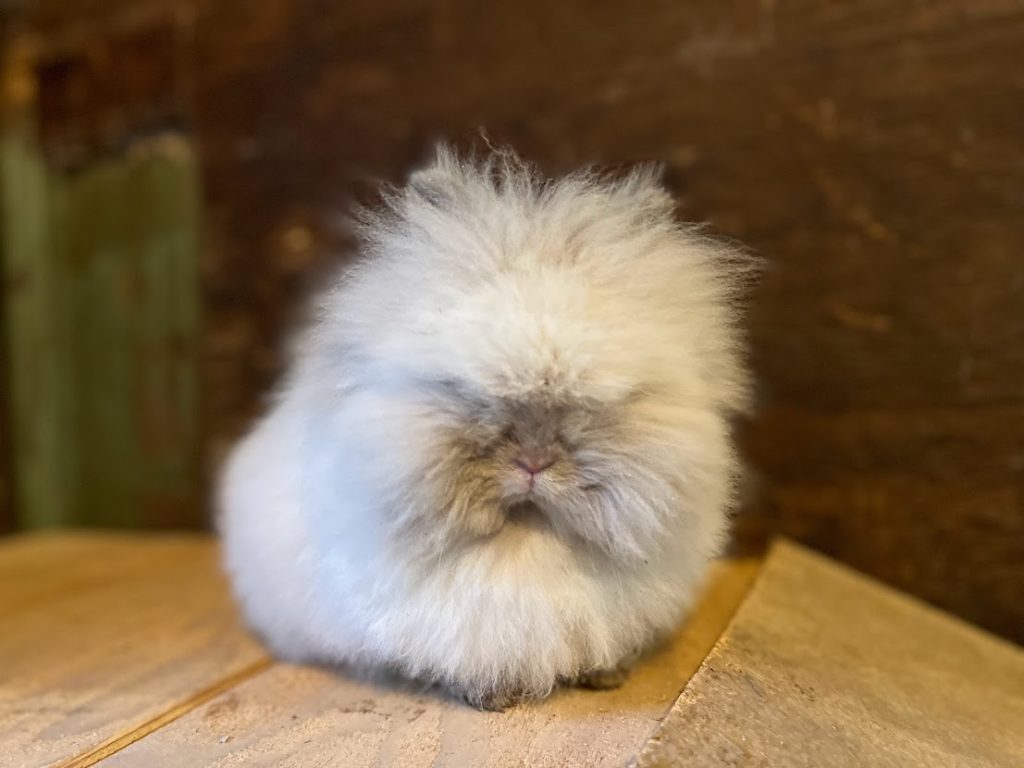
What do rabbits eat?
Rabbits are herbivores with sensitive digestive systems. A small digestive upset could prove deadly so it is important to always feed your rabbits quality feed & unlimited hay. If you are raising meat, fiber, or breeding rabbits it is especially important to look for quality feed. Producing high-quality fiber, plump rabbits, & babies require higher amounts of protein than a pet rabbit might need. You will want to look for pellets with 18% protein. This will often be labeled “performance” or “show” feed. You will have better luck finding this at a feed store vs a pet or grocery store.
Unlimited hay
A quality rabbit diet starts with unlimited access to hay. The fiber keeps their digestive system clean & working properly, and keeps their teeth trim. Hay should make up 75-80% of their diet. Timothy, Meadow, or Orchard hay are the best choices for adult rabbits. Alfalfa hay is a good ingredient to look for in their pellet feed, but should not be used as the hay portion of their diet. Alfalfa is higher in calcium & protein than Timothy hay. It is fine for growing babies (under 6 months) and nursing moms, but for the average adult rabbit, alfalfa is too rich. Hay should be offered in a hay manger and not spread on the ground to keep it dry & clean and should be refreshed often.
Pellet feed
Rabbits will need 1/2 cup-1 cup of pellet feed per day (depending on the size of your rabbit). Look for pellet feed that doesn’t have “treats” – no dried fruits or corn mixed in. I recommend using a pellet feed with at least 16% protein for pets and 18% for meat, fiber, or breeding rabbits.
Fresh Veggies & Fruit
While hay & pellets should provide all the nutrition your rabbit needs, many rabbit owners like to also offer treats of fresh vegetables & fruit. I give my rabbits Romaine lettuce every day (about 1/2 head per rabbit) and mix in other healthy treats occasionally. Many fruits are high in natural sugars which can mess with the rabbit’s digestive system and should be given sparingly. The same goes for carrots – lots of people think carrots & rabbits go hand in hand, but in reality, they are not a good choice for daily treats. Click here to read more about which vegetables & fruit are good for rabbits
Fresh water
Fresh, clean water should be offered unlimited every day. Be sure to clean their water dishes or bottles often. Rabbits do well drinking from both bottles that are attached to the cage or wall or also from open bowls. Some rabbits like to dump open bowls. Rabbits with large dewlaps or long hair might also have trouble with open bowls.
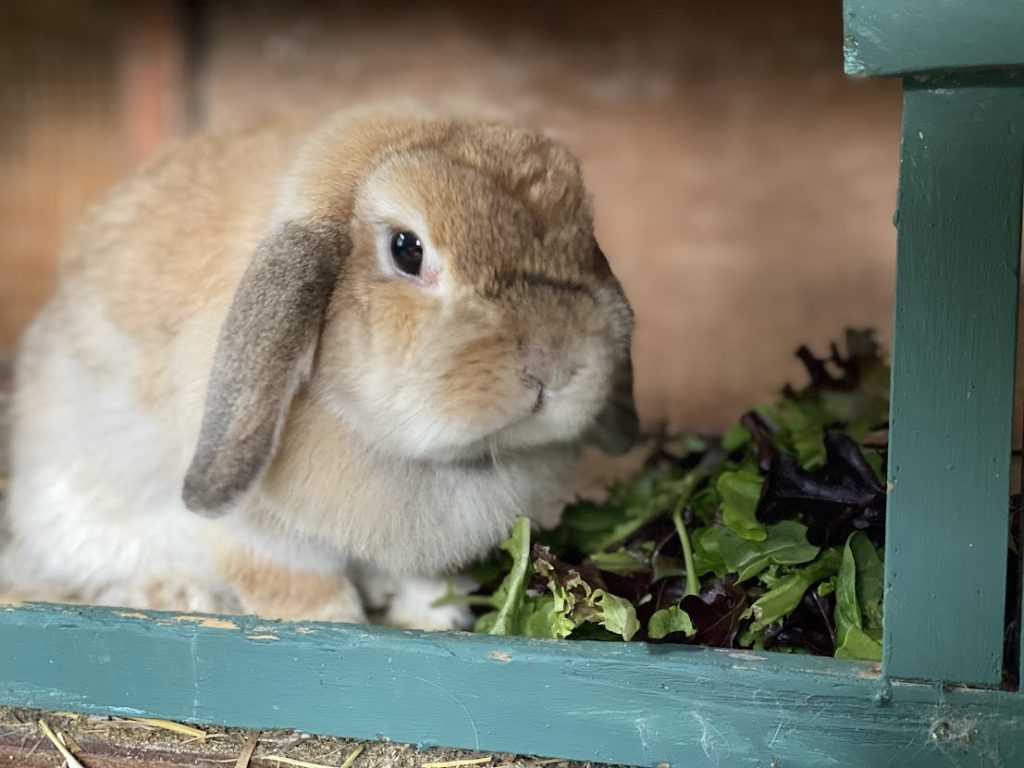
Are rabbits good with kids?
Of course the answer to this depends a lot on the kid and the rabbit. Just like humans, each rabbit has their own personality and some are more friendly & tolerant than others. In general, I would not recommend a rabbit as a pet for most children under 6-7 years old. Rabbits are similar to cats, most of them do not like to be carried around or squeezed. They are not cuddly stuffed animals. Also like cats, rabbits are independent and like to socialize with you on their own terms. They like to be pet….until they don’t. They have sharp teeth and nails that they will not hesitate to use.
Rabbits have fragile spines. They could break their back from being handled roughly, being dropped, or struggling to escape being held. Loud noises & quick movements tend to be very stressful for rabbits, and stress can lead to bad behavior or digestive issues. It is important children know not to share treats like cookies, chips, or crackers with their rabbit.
If you would like to get a rabbit for your child, be sure they understand the proper way to interact with them. Rabbits feel the safest when their feet on are the ground and they are not restrained. The best way to interact with your rabbit is to sit on the floor and allow the rabbit to come to you. click here for tips on playing with your rabbit. Encourage your child to do the same, using quiet voices and gentle hands.
Feeding and daily care could be handled by a responsible older child as long as an adult is also checking in. Grooming is likely an adult/older teen’s job as it requires you to handle the rabbit in a secure but safe manner. If your child forgets to feed the rabbit for the day it could cause irreparable digestive harm. If the rabbit’s enclosure is not cleaned properly she could get sore hocks or urine scalding on her feet & underside. A rabbit left unattended, locked in a cage alone for days on end is going to be bored and have behavioral issues.
Adopting a rabbit is best as a “family pet” rather than the “child’s pet” with a responsible adult checking daily. Rabbits can live 7-10 years so you should be committed for the long term when bringing home a bunny.
Their big personalities really come out the best when they feel safe & comfortable. If you & your children are patient and calm and have realistic expectations rabbits can make wonderful pets! Sturdier, larger breed rabbits (over 7-8 pounds) would be a better choice for families with young children.
Are rabbits good with other animals?
This again depends a lot on your rabbit and your other animals. You will want to move very carefully when introducing your rabbit to other household or farm animals. Most farm animals will tolerate and get along well with rabbits if they are in the same enclosure. The bigger issue here is mostly in disease management & living quarter management. Parasites are more likely to be a problem when grazing multiple species on the same space. Some parasites that don’t affect one species live as hosts in that animal but could be deadly to another species. Rabbits like to keep their living quarters fairly clean. They would not really enjoy having chickens pooping all over their sleeping quarters. When raising multiple types of livestock together, it’s a good idea for each species to also have appropriate spaces to retreat to when they need their space.
Rabbits are also likely to get along well with indoor pets provided those pets are well behaved. Cats & dogs are predators and some have a higher prey drive than others. That doesn’t mean that they can not get along with your rabbits though.
Start introductions slowly with the rabbit safely in its cage and the dog or cat on a leash at a distance. Do this for 10-15 minutes at first, gradually getting closer each day. When they both seem to tolerate this, you can move to having the rabbit in their exercise pen with the other pet in the room. Once you feel both animals will be safe you can try allowing them together.
My dogs will both chase wild rabbits outside, but they are smart enough to know which rabbits are our pets. When I bring my rabbits into the house the dogs sniff them but generally ignore them. Our cats love the rabbits, rubbing against them and sitting by them. The rabbits seem unbothered by this and will even hop along after the cat if she gets up and walks off. Every animal is different and sometimes instincts will take over. I would not recommend leaving a cat or dog unsupervised with a free-roaming bunny just in case.
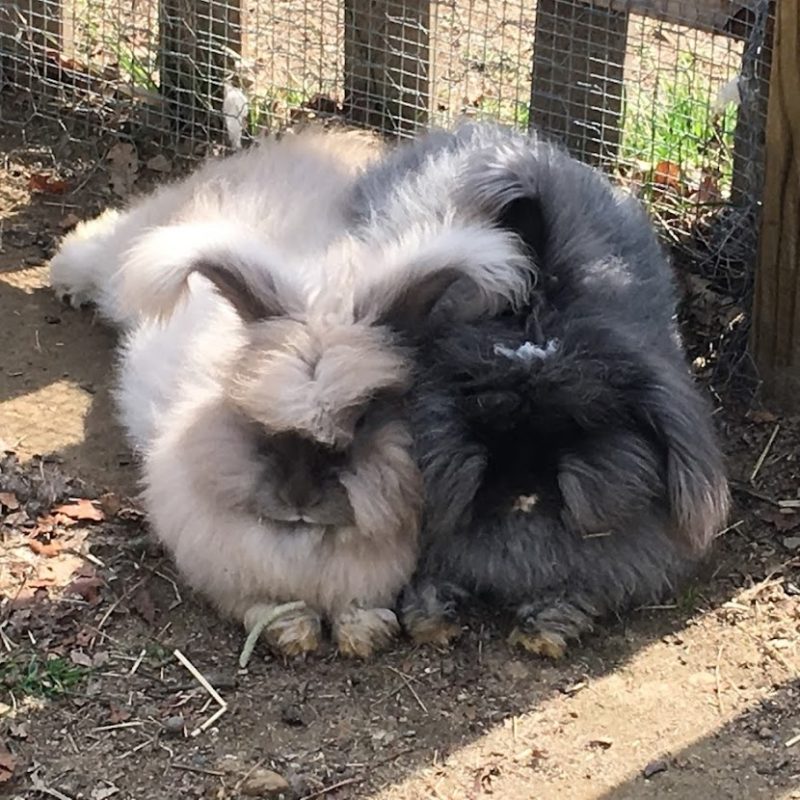





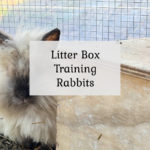

Bobbi
Sunday 2nd of February 2025
Why can’t I find someone to sell me a bunny? I had one for the longest time it just tapped around the house. It was beautiful. It was white. I have pictures of it. I had it for so long and it potty trained itself. Instantly never went on the floor, never chewed a wire ever. I got it when it was the size of my hand and then it was like with fur and everything. It looked like it was like Bigger than a watermelon couldn’t see his hair was so long over his eyes. I used to put it in a ponytail up with a little elastic band I just love that bunny. I keep trying to get another one and I can’t find any. I keep trying. Why can’t I get a bunny? I love them. I take such good care of them. I don’t have any other pets. I live by myself right now and it’d be perfect. I’ve always had bunnys my whole life even when I was a little kid. My mother had a saved one that was blind, and it was a floppy eared rabbit. I used to run around the living room and all over the place in the house and I couldn’t see what was going and we had big giant bunnies that were outdoor bunnies and we’ve always had bunnies And I absolutely love the one I had for the longest time and I miss having one so if you know anything you can tell me what to do I live in Glens Falls, New York. I have plenty of space for the bunny. I’m home all the time. I don’t keep it caged up all the time And I’ve been searching for so long. I deserve a bunny.
Liz
Wednesday 5th of February 2025
Oh no! You definitely need a bunny! Have you tried your local animal shelter? I know mine always has bunnies. I did a quick search for rabbit rescues near you and found this one, I bet they can help you! https://www.hoponhome.org/
The Rabbit Hop
Wednesday 8th of March 2023
I started getting a rabbit a few years ago because my friend had one and whenever I 'd visit him, I'd always play with his rabbits. They're playful and cute. Compared to other animals also, they're fairly not high maintenance and so easy to care for. They also inspired me to create a blog which I hope can help me connect with other rabbit owners and pet lovers out there. :)
Eleanor
Monday 8th of May 2023
@The Rabbit Hop Hi, I was just wondering what your blog is called? I would love to read it!
Liz
Wednesday 8th of March 2023
That is wonderful! Rabbits really are very sweet once you get to know them :)